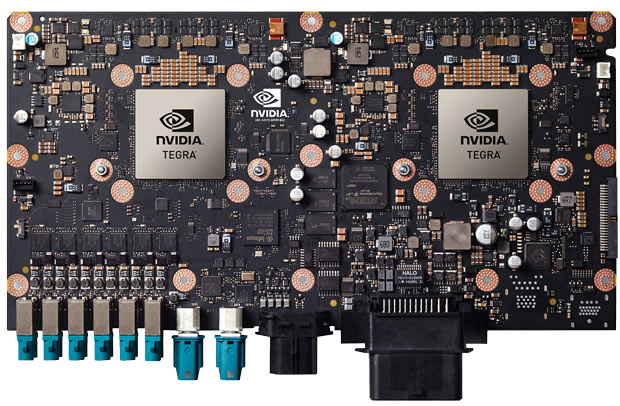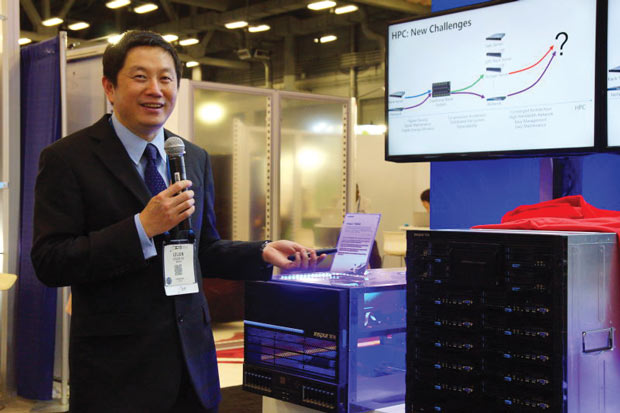The Emergence of Deep and Machine Learning

At CES 2016, NVIDIA announced the DRIVE PX 2, technology that is designed to help develop autonomous cars. Image courtesy of NVIDIA.
February 1, 2016
 At CES 2016, NVIDIA announced the DRIVE PX 2, technology that is designed to help develop autonomous cars. Image courtesy of NVIDIA.
At CES 2016, NVIDIA announced the DRIVE PX 2, technology that is designed to help develop autonomous cars. Image courtesy of NVIDIA.Imagine a host of products that can incorporate such applications as superb and accurate language translation from multiple platforms, forecast weather with pinpoint accuracy and learn chess within 72 hours—and play at the Master level.
Such applications have arrived, but many more sophisticated and complex applications are on the way, thanks to the panache of deep and machine learning that is finding its way into product development and applications.
The application of machine learning is widespread: Many different applications stand to benefit from it.
“There are proven applications of machine learning that will continue to grow as the underlying machine learning algorithms mature,” says Joshua Saxe, senior principal research engineer at Invincea Labs. “These include application categories such as targeted advertising, recommendation systems, fraud detection, spam detection and the like. As academically oriented work improves the accuracy and efficiency of computer vision, natural language processing and network analysis algorithms (which these application areas depend on) these applications will benefit and improve. Firms that can improve upon the techniques used in these applications, either by gaining access to improved data quality and quantity or leveraging achievements from academia, have an opportunity to achieve momentous results.”
High-Performance Calculation
“The rapid development of machine learning provides development opportunities for many companies,” says Hu Lei-Jun, vice president of Inspur – a multinational IT firm. “For the Internet industry, or even other industries of relevance to machine learning, machine learning’s period allows these users to develop more intelligent products; and for hardware technology vendors, the demand for high-performance calculation will gradually rise. In the past, the highest demand for Internet companies was to meet the throughput rate, while with the development of machine learning large-scale servers are needed to meet computational demand.”
For today’s progressive enterprise, machine learning is providing significant opportunities to move forward. Information afforded by analytics and the subsequent deep learning that data analysis affords is helping to drive decisions and make positive changes for many industries.
Data is, of course, critical to machine learning. The Internet of Things, with its potential for collecting and communicating so much data, will surely accelerate the development and utility of machine learning. The concept of machine learning is almost as old as computers. While it has developed rapidly in recent years, its future development may be even faster.
“This trend is closely related to the massive data brought by the rapid development of the Internet,” says Lei-Jun. “In 2015, global Internet users [reached] over 3 billion, which is nearly half of the world’s total population. In 2015, the world’s equipment connected to the Internet [reached] 4.9 billion units and this number will reach 26 billion by 2020. Only with such large data can the machine learning model carry out adequate training, which is the prerequisite for the development of machine learning.”A key pathway of machine learning will be to process the voluminous load of data by passing its computation through academia and into applications, and ultimately products. This path is most likely as the algorithms that deep learning uses are akin to the intellectual pursuit and brave challenge that researchers, students and faculty take on. But deep learning development needs to go further through the chain by instilling science and research into applications, and applications into products that the everyday world can use.
“Ideally, the slice of the technology industry that relies heavily on machine learning follows a simple progress model: Applications from industry and government help shape academic research, academic machine learning research improves or enables these applications, and businesses emerge that translate scientific achievements into successful products,” explains Invincea’s Saxe. “As in any major new field, there are risks to this model, such as large companies controlling access to lucrative datasets.”
Globant uses artificial intelligence and machine learning to transform Big Data into highly intelligent products and services. The company works with some household names like Coca-Cola, American Express and Southwest Airlines.
“Building social integration between systems and machine learning models has become crucial in today’s world because of greater user customization,” says Gustavo Aguirre, head of Globant’s Cognitive Computing Studio. “Companies must learn to monetize available data by extracting useful information using data science practices and extraction techniques based on Big Data platforms. As a result, this data can reduce financial risks, improve marketing campaigns, reduce operational costs and drive more engaging and personal connections with customers.”
 Hu Lei-Jun displays Inspur’s i9000 blade server at Supercomputing 15 (SC15). The technology is used for machine learning and supercomputing applications. Image courtesy of Inspur.
Hu Lei-Jun displays Inspur’s i9000 blade server at Supercomputing 15 (SC15). The technology is used for machine learning and supercomputing applications. Image courtesy of Inspur.Aguirre says that in the future, machine learning processes will become the standard due to data volume increase; precise, complete and omni-channel customer data availability; more actionable customer behavioral patterns in near real time; an increase of non-structured data; and the need for automation and improvement of human tasks.
“We can imagine machine learning of the future more closely mimicking the human brain to detect visual patterns: It can detect pedestrians while a car is in motion, recognize a friendly face or voice among others in a crowd, read a text to understand meaning using contextual information. These examples of non-structured information are a field where machine learning opportunities will grow,” says Aguirre.
Kitchen Robots to Cook Your Favorite Dish?
In the near term, expect machine learning to be at the forefront of priorities in smart design. Engineers and designers will likely incorporate the intelligence opportunity via machine design and systems design into product development at the earliest stages.
Saxe points out that there are some established applications of machine learning for which commercial markets are only just now emerging. These include self-driving cars, as well as areas like machine translation and machine learning based detection.
“There are also application areas of machine learning that perhaps have been conceived of and may become possible with big advances in the basic science, but are very ‘blue sky’ today,” says Saxe. “This includes the litany of science fiction-like applications: Robots capable of mimetic learning from humans—a kitchen robot that learns to cook an owner’s favorite dish —robots capable of performing psychotherapy, robotic teachers or robots that completely automate complex surgical procedures. There is always the possibility of ‘black swan’ innovations like these, but research in this category of applications will probably remain exploratory and academic for at least the medium-term.”
Smarter Machines and the Road Ahead
As the Big Data revolution continues to mature, deep and machine learning will drive the development of products. Digital twins—the interchange of data between virtual and reality (See: Seeing Digital Double) will be employed to produce a new chapter in the playbook of product lifecycle management. They will help pave the road ahead for “smart” machines.
“Over the coming years, you’ll see greater correlation between the real and virtual worlds,” says Eric Bantegnie, vice president, ANSYS’ systems business unit. “Virtual reality is taking shape. The ‘cyber-physical’ systems will take advantage of the vast amount of collected data to optimize field-asset performance through the use of the ‘digital twin’ concept. The digital twin will also drive improvements in product design as the real-world data will be used to improve simulation models and create better performance next-generation products.”
More Info:
Subscribe to our FREE magazine, FREE email newsletters or both!
About the Author
Jim Romeo is a freelance writer based in Chesapeake, VA. Send e-mail about this article to [email protected].
Follow DE





